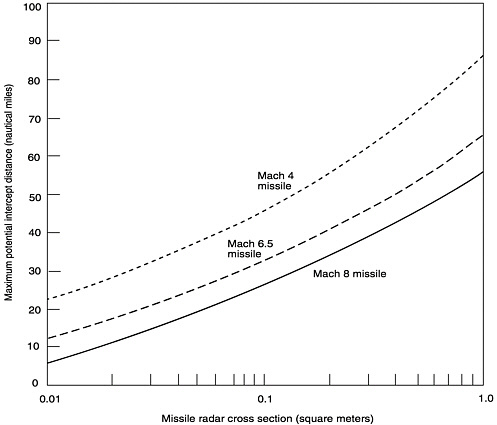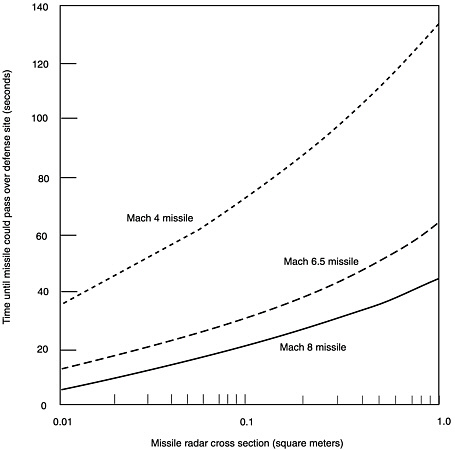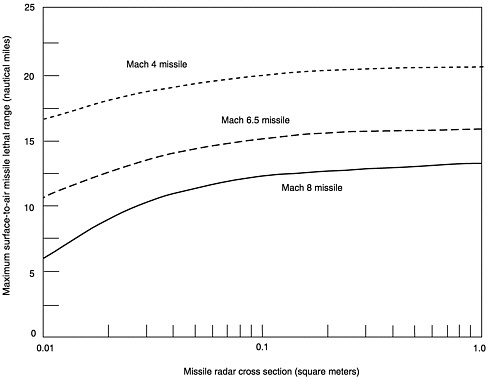APPENDIX C
Vulnerability of a Hypersonic Missile to Surface-to-Air Defensive Missiles
The committee performed a first-order analysis of the vulnerability of a hypersonic missile to surface-to-air defensive missiles. The analysis is one of several types of mission analyses the Air Force should conduct to make decisions about an operational requirement for a hypersonic missile system. The committee has included this analysis in the report because in the course of this study the committee was told that one of the advantages of hypersonic flight was that a hypersonic missile would be less vulnerable to surface-based air defense systems. Specifically, the committee was told that a missile with a speed of Mach 8 (approximately 1.3 nautical miles per second) would have a significant advantage over a missile with a speed of Mach 6.5 (approximately 1.1 nautical miles per second). The committee found that the marginally higher vulnerability of the Mach 6.5 missile compared to the Mach 8 missile can be offset with a moderate reduction in the radar cross section of the Mach 6.5 missile.
ANALYTICAL APPROACH, ASSUMPTIONS, AND RESULTS
The analysis was based on a simple model estimating the time to the detection and interception of a hypersonic missile. The analysis was performed by varying the radar cross section of the hypersonic missile and using typical modern surface-to-air missile system parameters. The analysis is based on the description of a simple one-on-one engagement model for a surface-based air defense system (Macfadzean, 1992). The performance of the interceptor is based on a model for miss distance that embodies the assumption of a command-guided, proportional navigation intercept (Alpert, 1988).
Characteristics of a Surface-to-Air Missile System
The characteristics of modern surface-to-air missile systems can be estimated from information in the open literature (Zaloga, 1993; Barton, 1995; Lemansky and Nenartovich,
TABLE C-1 Hypothetical Command-Guided, Surface-to-Air Missile System
|
Parameter |
Value of Parameter |
|
Reference radar range |
160 nautical miles |
|
Radar beamwidth |
0.7 degrees |
|
Radar measurement rate |
10 Hertz |
|
Maximum target altitude |
120,000 feet |
|
Maximum target speed |
Mach 10 |
|
Reaction time |
8 seconds |
|
Warhead weight |
330 pounds |
|
Missile time constant |
1.5 seconds |
|
Average missile speed |
Mach 5 |
1995; Yefremov, 1996; Bunkin and Svetov, 1997; Zaloga, 1997a; Zaloga, 1997b). A hypothetical, near future, command-guided, surface-to-air missile system was considered with the characteristics shown in Table C-1.
Limitations of Surface-to-Air Missile Fly-out
The limit of the interception range of a modern surface-to-air missile system can be easily estimated. Given the radar performance parameter, R0, which is the maximum range for initial detection of a target with a radar cross section of one square meter, the detection range for a target with a radar cross section, σ, is:
Rdet(σ)=R0·σ1/4
After initial detection, there is a time delay or reaction time during which a firm track is established, the target is identified, and the missile is launched. The time dependence of the target range, as measured from the radar, is:
where:
altitude = target missile altitude
Vtarget = target missile speed
The time dependence of the range of the intercepting surface-to-air missile, as measured from the radar, is:
RSAM(t)=VSAM·(t−τdelay)
where:
VSAM = surface-to-air missile average speed
t delay = time delay or reaction time
By setting these two equations equal, RSAM(t) = Rtarget(t), the maximum potential interception range, as limited by surface-to-air missile fly-out, can then be calculated as a function of several variables.
The performance of the hypothetical defensive system was estimated parametrically by varying the target missile’s speed [Mach 4 (supersonic), Mach 6.5 (hypersonic), and Mach 8 (hypersonic)], altitude (85,000 feet for the Mach 4 missile, 107,000 feet for the Mach 6.5 missile, and 115,000 feet for the Mach 8 missile), and radar cross section (from 0.01 to 1 square meter). For purposes of comparison, the missiles were assumed to have the same size and shape. It is not unreasonable to assume that a lower speed missile might be smaller than a higher speed missile and may also have a lower radar cross section.
The maximum potential interception distance of the defensive system using a fire control radar with an R0 of 160 nautical miles was analyzed and plotted in Figure C-1 as a function of missile radar cross section for three missile speeds. (The curves in Figure C-1 plot the fly-out limitation of the surface-to-air missile as driven by radar sensitivity, system reaction time, and average speed of the interceptor. They do not indicate the actual effectiveness of the surface-to-air missile system.) The maximum potential interception range for a target radar cross section of one square meter is approximately 55 nautical miles or more against any of the

FIGURE C-1 Maximum potential interception range as a function of the target’s radar cross section.

FIGURE C-2 Time from maximum intercept point until missile could pass over defense site, as a function of radar cross section.
three missiles. When the radar cross section is reduced to 0.01 square meter, the maximum interception range drops to about 22 nautical miles for the Mach 4 missile, 12 nautical miles for the Mach 6.5 missile, and 6 nautical miles for the Mach 8 missile. The difference in maximum potential interception range between the Mach 6.5 hypersonic missile and the Mach 8 hypersonic missile varies from about 6 nautical miles for a radar cross section of 0.01 square meter to about 10 nautical miles for a radar cross section of one square meter.
Figure C-2 displays similar information as a function of time rather than distance. This figure illustrates the time it would take for each missile to fly from the maximum intercept point to directly over the defense site. These times give an indication of the timeliness of the intercept as a function of radar cross section and missile speed. Figure C-2 shows again the strong dependence on radar cross section and the lesser effect on timeliness for speeds of Mach 6.5 to Mach 8 than for speeds of Mach 4 to Mach 6.5.
Lethality of a Surface-to-Air Missile
To complete the estimate of the performance of this hypothetical surface-to-air missile system, several additional performance parameters had to be estimated. The first of these is the lethal radius of the interceptor’s warhead. Lethality can be extrapolated from the estimates given in Table C-2.
When a linear curve is fit to the data in Table C-2, the estimated warhead lethal radius is approximately 100 feet for the hypothetical interceptor with a warhead of
TABLE C-2 Estimates of the Lethal Radius of Surface-to-Air Missiles from the Open Literature
|
Missile System |
Warhead Weight (pounds) |
Lethal Radius (feet) |
|
SA-3 |
130 |
40 |
|
SA-8 |
40 |
15 |
|
SA-9 |
15 |
5 |
|
SA-11 |
175 |
55 |
|
Source: Zaloga, 1989. |
||
330 pounds. Although the lethality of the warhead may be a function of interception altitude, this analysis assumes a constant lethal radius.
An adjoint analysis of the miss distance of a command-guided missile described in the open literature (Alpert, 1988) was used to estimate the miss distance of the hypothetical surface-to-air missile system. Radar antenna beamwidth, radar measurement rate, missile time constant, target speed, target radar cross section, and target maneuvers were the inputs to this part of the analysis. In this scenario, the command-guided surface-to-air missile miss distance has three components: miss due to range-independent angle noise; miss due to range-dependent angle noise; and miss due to target maneuver. If the target missile is in nonmaneuvering, level flight, the range-independent noise dominates the miss distance.
The miss distance was calculated as a function of missile speed (Mach 4, Mach 6.5 and Mach 8) and missile cross section (0.01 to 1 square meter). The maximum lethal range—defined as the distance on the ground from the surface-to-air missile site to the projected point of intercept—was determined by comparing the total miss distance to the lethal radius of the surface-to-air missile.
The results of the analysis show that the hypothetical defensive system is capable of engaging all three missiles. Figure C-3 summarizes the results for nonmaneuvering missiles. It should be noted that these ranges only apply to the forward sector of the surface-to-air missile radar because the radar is unlikely to be able to track and engage the missile after it has passed over the site.
On the basis of this analysis, the committee concluded that the vulnerability of hypersonic missiles may be loosely related to speed (in the range Mach 6.5 to Mach 8). By

FIGURE C-3 Maximum lethal range of a hypothetical surface-to-air missile system against a nonmaneuvering missile.
continuing to reduce the radar cross section below 0.1 square meter, the performance level of the defensive system continues to fall; the system’s effectiveness is limited eventually by radar sensitivity and interceptor fly-out. The useful defended area is minimal for a combination of hypersonic missile speed of Mach 8 and a radar cross section of 0.01 square meter. This analysis suggests that reducing a hypersonic missile’s radar cross section is a meaningful way of reducing its vulnerability.
SUMMARY OF WORK TO DATE
Hypersonic missiles are within the design envelopes of several modern air defense systems that have been designed to defend against tactical ballistic missiles with hypersonic terminal velocities. For the hypothetical defensive system considered above, and for a radar cross section of greater than 0.1 square meter, there is relatively little difference in the lethal range for hypersonic missile speeds between Mach 6.5 and Mach 8. However, the vulnerability of a hypersonic missile to surface-to-air missiles can be reduced through combined reductions in radar cross section and in-flight maneuvering, and, to some extent, an increase in speed. The lethality of command-guided, surface-to-air missiles is markedly reduced for targets with a radar cross section less than 0.1 square meter. Overall, the most important factor in hypersonic missile survivability is the size of radar cross section.
ADDITIONAL COMMENTS
Although the committee analyzed the vulnerability of a hypersonic missile to a hypothetical, command-guided, surface-to-air missile system, more advanced surface-to-air missile systems are being developed to counter the threat of tactical ballistic missiles, such as the U.S. Theater High Altitude Area Defense and the Naval Area Defense. These systems are designed with high performance radars and interceptors. For example, the radar has a much larger antenna aperture and can make much better angular measurements to guide an interceptor at longer ranges; also, the interceptor will probably have a higher average speed and will be more maneuverable than the hypothetical interceptor assumed in this analysis. The advanced systems could also use a terminal infrared homing seeker for accurate hit-to-kill against ballistic missiles. Therefore, by the time a hypersonic missile could be fielded (e.g., in 2015), it could potentially face a much more lethal threat from surface-to-air missiles.
REFERENCES
Alpert, J. 1998. Miss distance analysis for command guided missiles. Journal of Guidance, Control and Dynamics 11(6):481–487.
Barton, D.K. 1995. Recent Developments in Russian Radar Systems. Pp. 340–346 in 1995 IEEE Radar Conference. Piscataway, N.J.: Institute of Electrical and Electronics Engineers.
Bunkin, B., and V.Svetov. 1997. Fighting non-strategic missiles is a reality of today. Military Parade 21(3):130–133.
Lemansky, A., and N.Nenartovich. 1995. Modern air defense systems. Military Parade 2:62–65.
Macfadzean, R.H.M. 1992. Surface-Based Air Defense System Analysis. Boston: Artech House.
Yefremov, V. 1996. S-300V mobile multichannel air defense missile system. Military Parade 1:14–17.
Zaloga, S.J. 1989. Soviet Air Defense Missiles: Design, Development and Tactics . Coulsdon Surrey, U.K.: Jane’s Information Group Limited.
Zaloga, S.J. 1993. Russian tactical ballistic missile defense: the Antey S-300V. Jane’s Intelligence Review 5(2):52–58.
Zaloga, S.J. 1997a. Grumble: guardian of the skies: Part I. Jane’s Intelligence Review 9(3):113–118.
Zaloga, S.J. 1997b. Grumble: guardian of the skies: Part II. Jane’s Intelligence Review 9(4):153–156.





